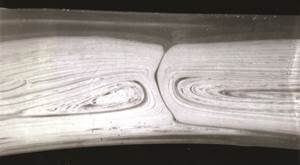NPE2018 New Technology Focus: Foam Fascination
A new physical foaming process and a significant enhancement of the MuCell process attract attention at the show.
Foam molding is seeing increased attention in the marketplace and is on display at several injection and blow molding booths in Orlando. New developments include the U.S. debut of the Plastinum foam injection molding process from Linde LLC (S24207), a leading supplier of industrial gases. This process involves impregnating plastic pellets with carbon dioxide gas in a pressurized chamber, or autoclave. Gas-loaded pellets can then be conveyed to the hopper(s) of one or more molding machines. The hopper is not sealed or under pressure, since gas will remain in the pellets at ambient conditions for 4-6 hr. No modifications to the injection press are required, except for use of a shutoff nozzle.
More new technology for physical foam molding is being introduced at NPE by Trexel (W551), whose new dosing equipment reportedly allows thin-wall molders to lightweight products to a level never before possible. The new MuCell P-Series delivers nitrogen under pressure as a supercritical fluid, and is able to do so at ultra-fast cycle times not previously possible with Trexel’s T-Series dosing equipment. Now, thin-wall packaging molders will be able to achieve 6% lightweighting, 7% faster cycles, 30% lower clamp tonnage, and 12% lower injection pressure, according to Trexel. Trexel is using the P-Series to mold what it calls a “groundbreaking” 6-oz (200-ml) yogurt cup with IML. Using StackTeck TRIM technology, it has ultra-thin-wall panels of only 0.008 in. (0.2 mm).
Trexel also is promoting what it calls “the first-ever design service dedicated to foamed components.” 2Limit is a joint venture of Trexel and GK Concept of Dresden, Germany, a specialist in product development, FEM calculations, filling simulation, prototyping, tool design, and mold trials. This venture is intended to fill a gap in the marketplace, making it easier to find design engineers skilled in the art of foamed part design—who know how to “break the rules” of conventional design for injection molding.
MuCell microcellular foaming can be seen at several more booths besides Trexel’s: Engel (W3303) uses MuCell together with its new DecoJect in-mold decorating process to provide uniform low-pressure packing and avoid sink marks and read-through of mold features.
Milacron (W2703) is using MuCell to produce an SUV door panel with map pocket using Milacron’s “Core Back/Reverse Coining” technique, whereby the mold is closed and then opened to a predefined position to allow foam expansion. Milacron achieves a Class-A surface on its MuCell foamed part using Roctool “Heat & Cool” technology with rapid induction heating. Yizumi-HPM (W3343) also uses MuCell together with rapid-heat/cool mold technology (based on a special TCU from Single Temperature Controls), a combination it calls Yizumi FoamPro.
Foam blow molding is also claiming attention at this NPE. W. Müller USA (W1983) is celebrating the first commercial application (20 L agricultural chemical containers) for its trilayer foam-core process, which involves injecting gas into the extrusion head. And Wilmington Machinery (W1823) is talking about foam blow molding on wheel, reciprocating-screw or accumulator-head machines. Applications could include bottles to large (40-gal) industrial containers and automotive parts such as tanks for fluids other than fuel.
Related Content
How to Mount an Injection Mold
Five industry pros with more than 200 years of combined molding experience provide step-by-step best practices on mounting a mold in a horizontal injection molding machine.
Read MoreHow to Select the Right Tool Steel for Mold Cavities
With cavity steel or alloy selection there are many variables that can dictate the best option.
Read MoreHow to Set Barrel Zone Temps in Injection Molding
Start by picking a target melt temperature, and double-check data sheets for the resin supplier’s recommendations. Now for the rest...
Read MoreWhat to Do About Weak Weld Lines
Weld or knit lines are perhaps the most common and difficult injection molding defect to eliminate.
Read MoreRead Next
How Polymer Melts in Single-Screw Extruders
Understanding how polymer melts in a single-screw extruder could help you optimize your screw design to eliminate defect-causing solid polymer fragments.
Read MoreWhy (and What) You Need to Dry
Other than polyolefins, almost every other polymer exhibits some level of polarity and therefore can absorb a certain amount of moisture from the atmosphere. Here’s a look at some of these materials, and what needs to be done to dry them.
Read More
























